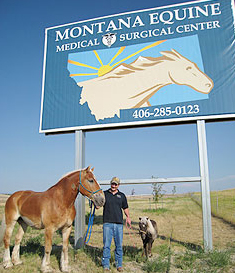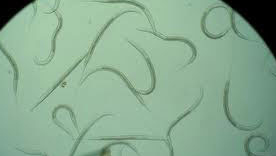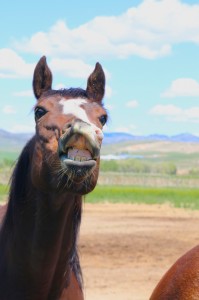Preventative Care
Weighing risks and benefits of intervention against the risks and benefits of doing nothing.The science of preventative medicine involves weighing risks and benefits of intervention against the risks and benefits of doing nothing. What are the risks of exposure? If exposed, what are the realistic rates of infection? Once infected, what are the effects of the disease? On the other hand, is the vaccination truly safe and protective?
But good medicine always requires a balance. In some cases, over-vaccination might increase a patient’s risks. Just as one example, some analysis of the 2011 Rhino outbreak in Ogden, UT suggested that horses who were more heavily vaccinated for Rhino seemed to be MORE likely to develop neurologic disease. Similarly, over-treatment for internal parasites only serves to bolster the worms’ natural defense mechanisms, increasing the risk of drug resistance. And improper use of antibiotics also fosters resistance. Yet without these powerful medications, many patients would suffer from the most mundane of ailments.
At Montana Equine, we will help you to weigh these factors, and put you in the best possible position to make critical decisions for your herd.
Vaccinations

The American Association of Equine Practitioners (AAEP) has a very comprehensive run-down of preventative care guidelines (AAEP.org link) but beyond these nationwide recommendations, the team at Montana Equine will help you formulate the best program for your horse’s specific risks and needs.
Fortunately, equine vaccine technology has improved, even compared with just 10 years ago. Not only are the newest vaccines MUCH more thoroughly tested these days (by measuring degree of protection, as well as safety), new technologies are emerging to confer longer-lasting, more balanced protection.
Still, there is no perfect vaccine (100% safe, 100% protective), and some of the most widely-used products are minimally protective and carry some actual health risks of their own. So, in choosing the best vaccination strategy for your horses, you have to balance the actual risk of infection (likelihood of exposure AND severity of the disease) with the potential benefit of vaccination (degree of protection conferred, risk of adverse effects).
There is also some very interesting ongoing research regarding some specific causes of local and/or systemic side effects (aka “reactions”), specifically including proteins like Bovine Serum Albumin (“B.S.A.”) which is in many products. If researchers can determine what makes horses have side effects, then the manufacturers can begin producing products that are less likely to cause reactions!
In addition to rare side-effects of vaccination, such as local swelling or allergic reactions, evidence exists that too-frequent vaccination is itself a possible risk factor. Research has suggested some risk of over-vaccination, and as a general strategy, we abide by the “less-is-more” approach, and will work with you to avoid mindless “over-vaccination”.
Overwhelmed yet? With our knowledge of emerging technologies and tried-and-true vaccines, as well as local and national disease epidemiology, our team at Montana Equine is exceptionally well-qualified to help you design a vaccine strategy that works for your particular circumstances.
Our veterinarians are always happy to help you weigh the potential pros and cons of vaccination in order to help you develop the strategy that makes the best sense for you.
Preventative Medicine Protocol:
CORE Vaccinations:
(Recommended for ALL horses, ALL the time)
- Eastern Equine Encephalitis
- Western Equine Encephalitis
- West Nile Virus Myeloencephalitis
- Tetanus
- Rabies
The good news: Most of the important preventable infectious diseases of horses do NOT
effectively spread from horse to horse, so barn-wide outbreaks do not occur.
The bad news: These diseases tend to be very serious, and are very often fatal, so boarding
and show barns typically want to do everything possible to ensure that none of their
boarders are stricken. While spread of these conditions from horse-to-horse is quite
unlikely, there are often significant liability implications for barn-owners if boarded horses
become affected.
Rabies:
Due to the increasing risk of Rabies infection in our region we recommend vaccination against this disease as part of the core vaccination strategy. The vaccine, given once-yearly, is also recommended as a core vaccine by the AAEP.
Please contact us with any questions or concerns regarding these general recommendations. Again, we believe that one size does not fit all, and are happy to help you develop the best vaccination strategy for your particular herd health situation.
PLAN:
Boarders – Require boarders to vaccinate annually for these diseases.
(Recommend late April/May)
Visitors – Strongly suggest that visitors should vaccinate annually.
Risk-Based Vaccinations (High Risk):
(Recommended for ALL horses in open barns, or travelling beyond SW Montana)
- Equine Influenza
- Equine Herpes Virus 1 & 4
The good news: These diseases are rarely diagnosed in our region. Vaccinations are quite effective at preventing the spread of equine Influenza, as well as the respiratory and reproductive forms of equine Herpes virus.
The bad news: These are viral respiratory diseases, both of which can spread rapidly when unvaccinated horses share airspace with a sick horse. Outbreaks can occur, with large percentages of the population getting sick, requiring a lot of veterinary care as well as long-term quarantine of facilities. This can create liability issues for barn owners. Not all vaccines are equally protective.
PLAN:
Boarders – Require boarders to vaccinate twice annually for these diseases.
(Recommend late April/May, and again in October/November)
Visitors – Require visitors to vaccinate twice annually for these diseases.
.
Risk-Based Vaccinations (Medium Risk):
(Recommended for SOME horses in SW Montana, depending on local factors)
- Potomac Horse Fever (PHF)
The good news: Potomac Horse Fever is not spread from horse to horse, and only occurs with direct exposure to the insects that carry the disease. This is much more likely to happen in certain endemic areas.
The bad news: PHF infection can be acquired from hay grown in the endemic areas. Horses can develop life-threatening complications like laminitis, especially when not treated promptly.
PLAN:
Boarders & Visitors: Consider vaccination for all boarders and visitors, especially when risk is deemed high. The vaccine can be administered twice yearly, but it is most important to target vaccination in mid-Summer, since the peak season in Montana usually starts in August, and because immunity may wane rapidly.
Risk-Based Vaccinations (Lower Risk):
(Recommended for SOME horses in SW Montana, depending on local factors.)
- Streptococcus equi equi (“Strangles”)
The good news: Although outbreaks occur from time to time, Strep equi is not highly prevalent in our region. It can be a serious disease, but when medical care is well-managed, the vast majority of horses make a complete recovery.
The bad news: During an outbreak, the risk of becoming infected is obviously higher. Strep equi can spread readily from horse to horse, especially when animals are kept together in close quarters or with shared waterers, wheel-barrows, personnel, etc. Vaccination can help minimize likelihood or severity of infection (depending on which vaccine product is used), although vaccine side effects are somewhat more common with either of the 2 available commercial products.
PLAN:
Boarders & Visitors: Consider vaccination, especially when risk is deemed high.
Pregnant Mares:
Vaccination with “killed Rhino” (we most often recommend “Pneumabort K”) is a critical means to minimize the risk of abortion due to Rhinopneumonitis (Herpes) Virus. This should be given at the beginning of the 5th, 7th, and 9th months of gestation.
Foal Shots:
Foals born to mares fully vaccinated at 10 months of gestation:
- Begin vaccinating at 5 months of age
- Plan for booster shot at 1 month post-vaccination
Foals born to mares who have not been vaccinated (other than Pneumabort):
- Begin vaccinating at 4-6 weeks of age
- Plan for booster shot at 1 month post-vaccination
Printable PDF: Preventative Medicine Protocol
Please contact us with any questions or concerns regarding these general recommendations. Again, we believe that one size does not fit all, and are happy to help you develop the best vaccination strategy for your particular herd health situation.
Deworming
 As a result of recent research, our deworming protocol has changed at Montana Equine. In the past, we have recommended deworming four times per year with specific de-wormers targeting specific parasites. Due to the high concern for the development of parasite resistance to our current available dewormers, updated recommendations have been made which have the potential to save money on dewormer within a herd and minimize the use of dewormers in individual horses. The most recent recommendations suggest that we treat adult horses (approximately 5-15 years old), senior horses (16+ years old), and foals/young horses (<5 years old) separately and utilize fecal egg count screening for each age-group to help establish deworming protocols. We no longer recommend rotation of de-wormers in most circumstances.
As a result of recent research, our deworming protocol has changed at Montana Equine. In the past, we have recommended deworming four times per year with specific de-wormers targeting specific parasites. Due to the high concern for the development of parasite resistance to our current available dewormers, updated recommendations have been made which have the potential to save money on dewormer within a herd and minimize the use of dewormers in individual horses. The most recent recommendations suggest that we treat adult horses (approximately 5-15 years old), senior horses (16+ years old), and foals/young horses (<5 years old) separately and utilize fecal egg count screening for each age-group to help establish deworming protocols. We no longer recommend rotation of de-wormers in most circumstances.
Fecal egg count screening aka “fecal float”: Fecal floats help us identify “high shedders”, or horses that shed a large numbers of parasite eggs in their manure, and “low shedders”, or horses that shed a small number of parasite eggs. The goal with performing routine fecal floats is to minimize the effects of parasite resistance, reduce the de-worming treatment for the overall herd, and minimize the money spent on de-wormer. In other words, horses that are not burdened by parasites will not receive medications that they don’t need. Montana Equine is able to utilize a variety of fecal float methods based on your needs, including the Parasight© digital egg counter which can provide highly sensitive and accurate egg counts in hospital. Keep in mind that horses are affected by some parasites that are not detected by routine methods, so your veterinarian may still recommend tailored deworming protocols in horses with “negative” fecal floats.
Individual factors: These factors (and others) could play a role in your veterinarian’s decision to tailor a specific deworming protocol for your horses:
- Distribution of the age of horses on the property (i.e. younger vs. older horses)
- Management strategies of horses on the property (i.e. pasture access, etc.)
- Climate/geographical region and any known dewormer resistance in the area
- Amount of traveling and comingling that horses do on other properties (including travel to other states for extended periods of time)
- Individual horse factors such as any clinical signs, diet, other medical history, medications, etc.
Herd Management: Keep in mind, manure is the main source of parasites and it houses the larvae and egg stages of the parasite’s life cycle. Ingestion of these eggs and larvae is what causes parasitic infection in your horse. A very effective environmental approach to decreasing the number of eggs shed and parasite burden is removing manure from grazing areas and/or properly composting manure prior to spreading it on a pasture.
How can we help? We realize that there are herd situations where obtaining an individual sample from every horse might be challenging and that individual screening requires a larger amount of money up front. Please call us to discuss strategies and discounts on fecal testing for larger groups of horses.
__________________________________________________________________________________________________________________
Preventative Medicine Protocols:
- Adult horses (5-15 years old): In an adult horse-herd setting, 20% of horses in any given herd will carry and shed 80% of the worm burden (aka “high shedders”). We recommend performing once to twice yearly fecal float to identify high and low shedders.
- Low shedders: Receive “baseline deworming treatment”—generally once to twice yearly deworming
- This protocol should include a dewormer in the fall that covers for tapeworms, such as Zimectrin® Gold, Equimax, or Quest® Plus
- High shedders: Receive “surveillance-based treatment”—generally receive baseline treatment plus one to two more treatments per year
- Senior horses (generally 15+ years old): Horses may be at risk to become “high shedders” later in life, particularly those with Cushing’s disease—therefore continuing fecal floats in this group is important to identify if there is need to change deworming protocols as your horse gets older.
- Continue deworming as high or low-shedder as previously indicated, but consider that you may need to treat as a high shedder if your fecal egg counts increase in numbers
- Foals and young horses (under 5 years of age): Young horses are affected by different types of internal parasites than adults (e.g. “ascarids” or roundworms) and therefore should receive different deworming protocols than adults. Roundworms can be associated with serious and potentially fatal disease in foals, therefore we recommend working with your veterinarian to formulate a deworming protocol for foals on your property.
- Foals (0-12 months): This age-group should start their deworming protocol at 2-3 months of age and be dewormed every 2-3 months until 9-10 months of age. We recommend starting fecal floats at around 5-6 months of age.
- Note: The type and dose of dewormer for young foals is different than for adult horses, please consult your veterinarian for further guidance
- Yearlings to four-year old horses: This age-group can have variable worm burdens, therefore it is important to perform fecal floats once to twice yearly and typically treat them as high shedders until they mature
https://aaep.org/resource/internal-parasite-control-guidelines/
Dental

Dental Health
Dental health for your equine friends is at least as important as other types of general and preventative health care, but too often, it is overlooked.
When you have one of our licensed veterinarians perform a thorough oral exam, you get a lot more than a “float”. A good exam also includes evaluating the periodontium, occlusal surfaces and external musculature.
In order to be this thorough, the horse is typically sedated, and a speculum is placed so that we can perform a complete evaluation. That means that we will also perform a physical exam to ensure your horse can be safely sedated.
Performing a thorough exam requires a high level of expertise and training. Without veterinary training, equine dentists are not equipped with the knowledge or expertise to safely provide this level of care. When provided by our veterinarians, who have advanced training in equine dental care, yearly oral exams will not only increase the quality and length of life for your horses but will also help prevent costly complications.
At Montana Equine, we firmly believe in providing the best in dental health, so many of our vets regularly travel to learn from the experts in the field, ensuring we offer the best care in the industry. We also have the specialized tools required provide this level of expertise. This includes digital radiography, oral optics, to name a few. These tools allow our team to diagnose the health and prognosis of any individual tooth or teeth to make the best plan. If a tooth is considered non-viable, we also have the specialized elevators, extractors and expertise necessary to extract the tooth, typically done under standing sedation.
Sometimes clients have questions or concerns regarding motorized dental instruments, which have become very advanced over the past 25-30 years. These tools do not just shorten the duration of a given procedure, but also allow a very high degree of precision to dental floating and other treatments. They can reach areas where hand-floats just cannot access. For most patients, these tools really optimize our ability to carefully and efficiently perform dental floating.
It is true that some poorly-trained veterinarians and dentists caused injuries and “over-floated” especially during the early era of mechanized dentistry in the 1990s and early 2000s. And even still, despite the major advances in instrumentation, poorly-trained practitioners can still cause injuries. But again, At Montana Equine, all of our veterinarians regularly complete ongoing Continuing Education training, and all of our veterinarians stay current on the best techniques for safe use of these tools.
For the vast majority of horses, light sedation, a speculum exam and the use of very specialized dental instruments provides the optimum opportunity for diagnosing and treating problems, as well as for routine maintenance. In some rare cases, or when there are other concerns, our highly trained vets can perform dental work without sedation or even a speculum.
If you have questions regarding dental treatments or instrumentation, or would like to request a non-mechanized hand-float treatment for your horse, please ask!
Montana Equine is happy to offer a wide range of dental care both at our clinics or in the field. We also offer a fall dental special, please give us a call with any questions you may have.
- Routine Dental Care
- Point, Hook, Step and Wave reductions
- Gentle Geriatric Dentistry
- Periodontal Therapy
- Dental Radiography
- Standing Extractions
